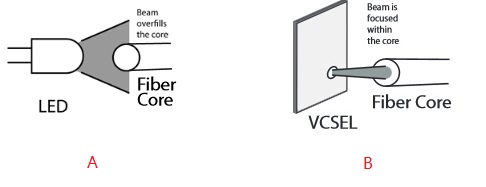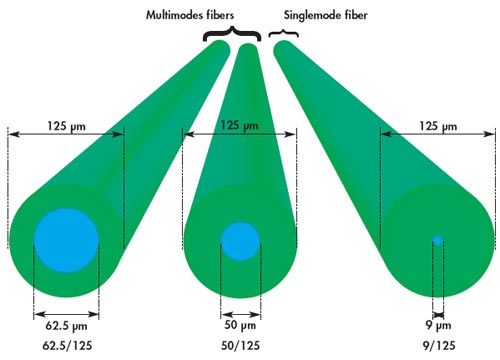Multimode optical fiber is a type of optical fiber mainly used for transmission over short distances, such as in a building or on a campus. Typical multimode optical fibers support data rates from 10 Mbps to 10 Gbps over link lengths of up to 600 meters. It can offer reliable, flexible and cost effective cabling solutions for local area networks, central offices and data centers.
According to the core and cladding diameters, multimode optical fiber can be divided into 50/125 µm and 62.5/125 µm. 50 µm and 62.5 µm refer to the diameters of the fiber core, which is the area that carries light signals. 125 µm means the cladding diameter of the fiber. The cladding confines the light to the core as it has a lower index of refraction. Cable construction is shown in the following diagram indicating the cable core, cladding and outer jacket diameters. Currently, there are four types of multimode optical fibers: 62.5µm multimode optical fiber (OM1), 50µm multimode optical fiber (OM2), laser-optimized 50µm multimode optical fiber (OM3) and laser-optimized 50µm multimode optical fiber (OM4).

When optical fiber was introduced for 10Mbps and then 100Mbps Ethernet, light-emitting diode (LED) light sources and 62.5µm fiber were used. LEDs overfill the fiber core, so larger core diameters mean more light is collected, and thus data can be carried farther as shown in the following picture A.
In order to achieve 1Gbps performance, the light source was upgraded to vertical-cavity surface-emitting laser (VCSEL). VCSELs can switch more rapidly than LEDS, which makes them better for higher data rates. Moreover, VCSELs emit much smaller and more sharply focused beams, coupling more power into the fiber for greater efficiency as the following picture B shown. With a VCSEL light source, all of the light is coupled into the fiber, so a larger core diameter does not gather more light. In fact, a larger core diameter transmits the light less efficiently as a result of modal dispersion. Using 50µm fiber decreased modal dispersion and then increased the reach of 1Gbps fiber cabling.

62.5µm fiber could support 2km campuses at 10 Mbps because more light for LEDs could be coupled into its larger core. And it dominated the premises market for more than a decade. However, with faster transmission rates and higher bandwidth demands, changing market conditions was imperative. So 50µm fiber has been established as the best solution for applications > 10 Mbps. The 100Mbps Fast Ethernet standard invited the use of LEDs that take advantage of lower fiber attenuation at 1300nm wavelength, which offset the LED coupling loss into 50µm fiber caused by its smaller core diameter. Hence, 50µm fiber could support the same 2km reach at 100 Mbps as 62.5µm fiber.
As data rates rise to Gigabit speeds, 62.5µm fiber is stretched beyond its performance limit because of its lower bandwidth at 850 nm. By contrast, 50µm fiber has as much as ten times the bandwidth of the 62.5µm fiber, which enables support of 1Gbps and 10Gbps applications. As 1Gbps and 10Gbps transmitters use small spot-size lasers, concerns over power coupling efficiency into 50µm fiber are no longer an issue. Moreover, the laser-optimized 50µm multimode optical fiber can offer the most secure and least-cost upgrade path to higher-speed networks as it is able to support 40 and 100Gbps data transmission.
As stated above, 50µm multimode optical fiber is more preferable than 62.5µm multimode optical fiber. Using 50µm multimode optical fiber can bring benefits of faster transmission rates and higher bandwidth. If you have not put 50µm multimode optical fiber into use, it is time to employ 50µm multimode optical fiber for higher performance on your network.


